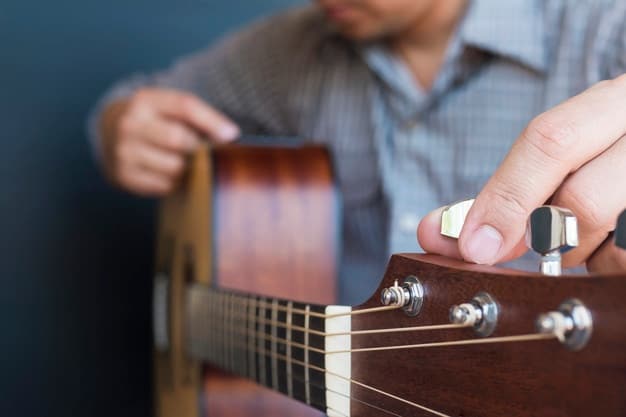Many famous guitarists like to tune their guitars half-step down.
The first name that pops into my head is Slash.
But also, legendary guitarists like B.B. King, Stevie Ray Vaughan, Jimi Hendrix played many songs in down tuning.
Guitarists tune their guitar half-step down for many reasons. The most compelling one is probably to favor the vocal performance by transposing songs into a lower key, making it easier on the singer. But other reasons might include a heavier sound, lower string tension, and easier chord voicings in some keys.
To utilize the full potential of half-step down guitar tuning, let’s discuss the music theory behind it and some reasons why you might consider adopting it
Are you ready to get started?
Let’s go!
Tuning A Guitar Half-step Down: What Does It Mean?
The standard tuning of a guitar is E B G D A E. If we tune each string a half-step lower, then the tuning becomes Eb Bb Gb Db Ab Eb.
| Tuning/String | 6th string | 5th string | 4th string | 3rd string | 2nd string | 1st string |
| Standard Tuning | E | B | G | D | A | E |
| E Flat Tuning | Eb | Bb | Gb | Db | Ab | Eb |
This half-step down tuning configuration is known as E flat tuning or half-step down. Basically, by using this tuning configuration you are transposing your guitar down a fret.
And one thing to remark is that we are transposing the tuning. E flat tuning just means moving every note down 1 fret. There is just one semitone difference with the standard.
So, when you are using this tuning you are not actually experimenting with a new note layout or relationship between strings.
In fact, the relationship between your guitar’s strings is the same in E flat tuning as it is in standard guitar tuning.
As a result, if you play the E chord that you used to play at standard guitar tuning, it will ring up with the notes of the E flat (Eb) chord in E flat guitar tuning.
Similarly, every chord will transpose by half-step down as well.
To make things extra clear: Imagine you shifted every note down one fret. Well, there’s no need for using your imagination, that’s what you actually did.
Difference Between half-step Down Guitar Tuning & Alternative Guitar Tuning
You can also apply half-step down tuning in alternative guitar tunings too.
For example, if you tune a half-step down a drop D tuning (D B D G B E) you will simply have the drop Db tuning (Db Bb Db Gb Bb Eb).
With alternative guitar tunings, you will likely need to learn new chord shapes in different fret positions.
But with a half-step down tuning, you can play the same chord shapes and melody lines.
Everything will just transpose by half-step down.
Benefits of a Half-step Down (E Flat) Guitar Tuning
Now that we understand what tuning down a half-step really means, let’s discuss what’s the point of doing it.
You see, there are many valid reasons to do so, but after all, it’s a matter of preference.
It’s not unlikely to find a guitarist that enjoys this tuning just because.
Some singers insist on transposing songs down a half-step
When singers get older, have a bad day, or are performing a cover song, they may want to transpose the song down.
They find it far more comfortable to sing in a half-step lower tuning than a higher tone.
Singing a song in a lower tone is much more relaxing for some singers.
You can notice the difference in the vocal tone of a live performance and studio recording of the same singer.
This is particularly true, as mentioned, for older vocalists, and especially for those who didn’t take appropriate care of their instrument during their careers.
Depending on a singer’s vocal range, reducing the pitch of the guitar by a half-step can help him catch up.
Half-step Down Tuning Means Less String Tension
As the strings are loosened and tuned down by a half-step, each string tension drops noticeably.
This lower tension to the touch might favor fretting, bending and vibrato, and is preferred by many players.
The strings become softer and easy to play the notes and chords. Getting barre chords to ring will be easier with a down-step guitar tuning.
In that sense, half-step down tuning will be excellent for beginners.
Beginners usually trouble a lot in the first phase of learning guitar to play notes and chords.
It’s because they are not used to dealing with the required amount of force to press the strings to ring clear tones.
This leads many beginner guitarists to quit before they have a chance to know every aspect of this amazing instrument.
It Makes it Easier To Play Some Chords in Open Position
Even for most beginners, after some months, barre chords stop being an unsurpassable hurdle.
However, even with my nearly 20 years of playing guitar, I still prefer avoiding them.
Not always, of course, but in many cases, open chords feel just right.
With a half-step down tuning, you could play some chords in an open position that with a standard tuning will only be available by employing a barre.
Songs in specific keys may benefit from the ability to use these open string voicing.
And also your fretting hand will thank you for the reduced strain.
It Makes Bending Easier
Bending is one of the important techniques for playing guitar solos.
It is also one of the best reasons for breaking guitar strings too.
Tuning by a half-step down, as I mentioned earlier will decrease the string tension and allow for easier bends without that much demand on the strings.
Better for Thicker Gauge Strings
Another of the many reasons why guitarists tune down a half-step is that it allows them to use heavier gauge guitar strings.
Thicker gauge strings are preferred by many players for many reasons. In GearAficionado I have an article dedicated to how different string gauges affect your tone.
Also, we have an extensive post about the difference between 09 and 10 strings.
But to be brief here, it’s important to know that the thicker the strings, the higher the tension they are put under to achieve equal tunings.
A guitar using the standard tuning set up with thicker strings will be harder to fret and play for many players.
So, in that case, tuning the guitar by half-step down can come in handy.
Sounds Heavier
A half-step down tuning, as its name implies, makes a new lower pitch available when you play the open 6th string.
Although slight, this darker sound might be a great platform for heavier riffs and more grungy tones.
If you want your music to sound deeper and more aggressive, stepping down a half-tone can produce some impressive results.
Conclusion
Whether you are looking for a fresh sound to inspire you, or some of the reasons mentioned in this article really resonate with you, giving a try to a lower tuning is something every guitarist should play with at least once.
Now, the next question you might be asking is if changing tunings will require you to re-setup your guitar…
But don’t worry, I’ve got you covered.
Finally, experimenting with your instrument is something that should drive your creativity each time you embark on it.
Don’t restrain yourself, and just give it a try.
Worst case scenario you tune back half-step up, and nothing happened.

Hello there, my name is Ramiro and I’ve been playing guitar for almost 20 years. I’m obsessed with everything gear-related and I thought it might be worth sharing it. From guitars, pedals, amps, and synths to studio gear and production tips, I hope you find what I post here useful, and I’ll try my best to keep it entertaining also.





